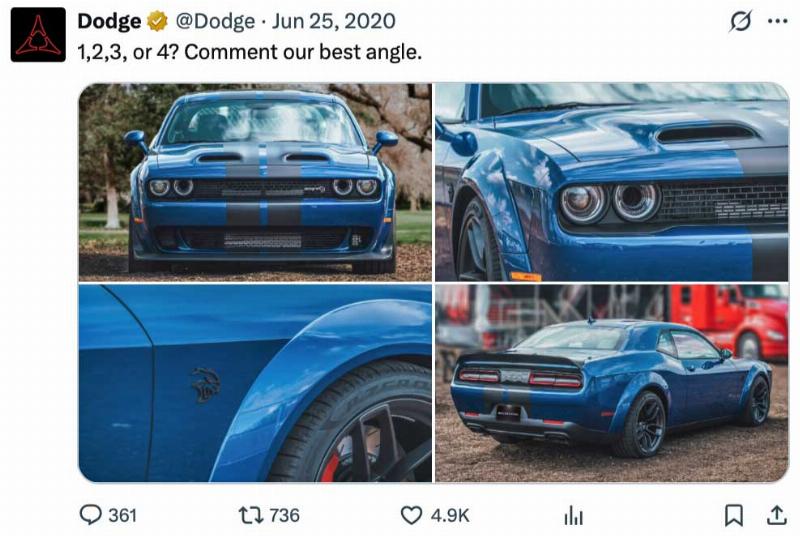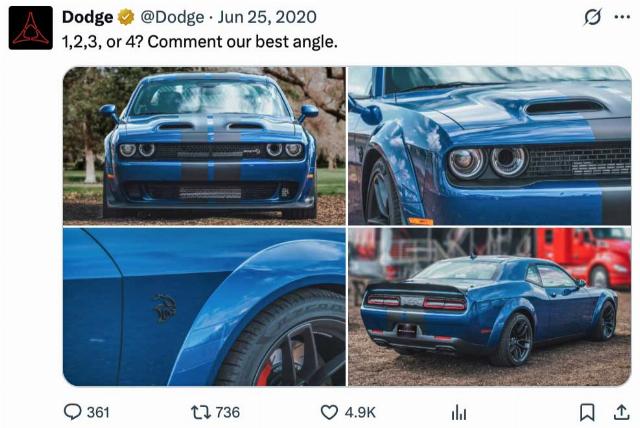


It’s the Fourth of July, that most American holiday! Today we celebrate our independence; it’s our true “no Kings” day. There will be parades, barbeque, Americans pleased to be Americans, because being born in America means winning life’s lottery.
Among our uniquely American traditions is the American muscle car, a wide, low, two-door sports coupe propelled by increasingly powerful V8 engines. The Mustang, Camaro, Challenger and Charger typified them. Original models were unsophisticated by modern standards, designed for straight line acceleration, but as technology advanced, so did they, and handling dramatically improved.
Today, only the Mustang and Charger yet exist as newly manufactured vehicles. Ford has continued to build internal combustion engine--ICE--Mustangs which gather no dust on dealer’s lots. Dodge, however, has not been so canny.

Graphic: Dodge Challenger in more lucrative days. X post screenshot.
In August of 2024 I wrote Dodge emasculates muscle cars. In 2022, Dodge announced it would discontinue ICE Challengers and Chargers beginning in 2024. They’d be replaced with EVs featuring “Fratzonic Chambered Exhaust” and “eRupt Multispeed Transmissions.” Considering EVs have no transmissions, nor do they produce exhaust (unused electrons?), what could those terms possibly mean?
Recognizing muscle car owners buy them for the sound and feel of powerful V8s, Dodge installed high-watt stereos that simulated the sounds of V8s. They combined that faux-authentic muscle car experience with software that would momentarily interrupt electric motor power transmission to simulate the feel of a transmission shifting gears. Potential muscle car buyers weren’t impressed.
Dodge started the deliveries of the new-generation Charger in the first quarter of 2025. However, things don't go well for EVs that broke American the muscle car tradition. The firm sold more Challengers and former-generation Chargers than the new Charger Daytonas. Dodge's total sales declined by 49%.
Dodge ended conventional Charger and Challenger production in December of 2023 but made a limited number of “last call” vehicles. It is those remaining “former-generation” vehicles that have outsold the new EV Charger and the ICE-powered Charger Six Pack, a twin-turbocharged in-line six cylinder. Neither vehicle is apparently thrilling muscle car fans, and sales remain dire:
Dodge's sales plunged in the first quarter of the year, reaching only halfway the sales of the same period of 2024. The brand moved only 21,731 vehicles in January, February, and March 2025. It sold 42,948 units in the first three months of last year.
Muscle cars have always been a niche market whose parameters have been well known and largely successfully exploited by American auto makers. That’s what makes Dodge’s moves so jarring. Even before the return of Donald Trump and the dismantling of government incentives and rules forcing EVs on Americans, the public had finally wised up.
Americans began to understand EVs were impractical for all but the roughly 7% of high wage earners that have historically bought them. They lose about half their range in cold weather, their actual, practical range has always been far less than the optimistic estimates of manufacturers and the Government and they take a long time to recharge if a working charger can be found. They cost far more than comparable ICE vehicles, tires wear out much faster and are more expensive, repair and insurance costs are sky high and installing home fast chargers, if local infrastructure will support them, can easily exceed $10,000 dollars. It’s likely this realization, and the realization Democrat government would try to force EVs on everyone, helped elect Trump.
Given billions to build a nationwide network of a half-million fast EV chargers, former Transportation Secretary Pete Buttigieg, who was largely AWOL, managed to build only eight. Questioned about this performance, he noted building EV chargers is like, hard, man.
Particularly for young potential buyers, EVs are frustrating. Apartment dwellers commonly have no charging options, and running a house current cord to their EV takes 24 hours or more for an 80% charge. EV and battery makers have largely gone out of business, and there is virtually no used EV market, which hasn’t made it any easier for Hertz to unload tens of thousands of EVs it unwisely bought.
In April of this year there were 657 Chargers and 691 Challenger still in inventory. The used market for earlier Chargers and Challengers shows every sign of becoming increasingly lucrative. However, Dodge might be returning to some semblance of capitalist reality:
After Carlos Tavares' departure, Stellantis has been reportedly considering the return of the HEMI. It is the news that the HEMI diehards have been dreaming of hearing since the engine's demise, with the Charger and Challenger, in late 2023. Its comeback into the Charger lineup might be a massive boost for the model's sales. If rumors are anything to go by, we should expect a HEMI-powered Dodge Charger by 2026.
Giving people what they want at a price they’re willing to pay is the American way. Now we see if Dodge understands that.
On a different subject, if you are not already a subscriber, you may not know that we’ve implemented something new: A weekly newsletter with unique content from our editors for subscribers only. These essays alone are worth the cost of the subscription.
Mike McDaniel is a USAF veteran, classically trained musician, Japanese and European fencer, life-long athlete, firearm instructor, retired police officer and high school and college English teacher. He is a published author and blogger. His home blog is Stately McDaniel Manor.
